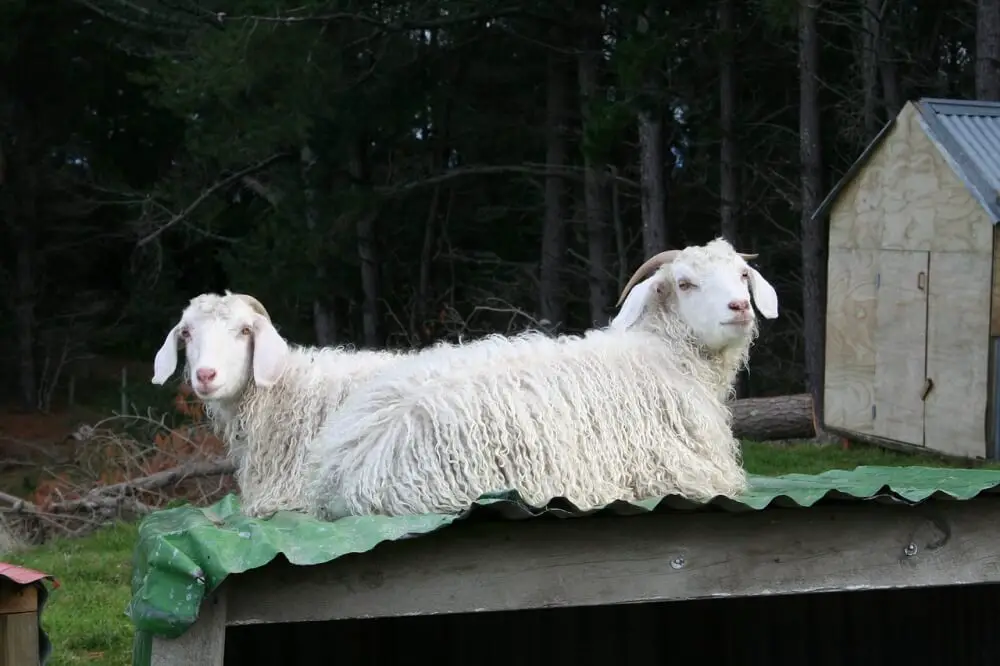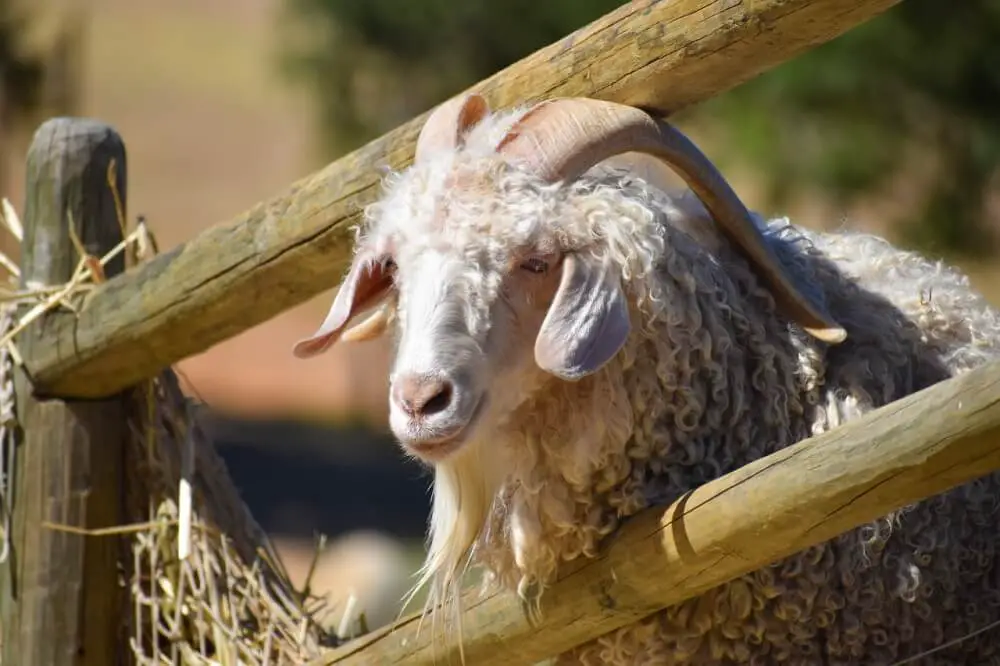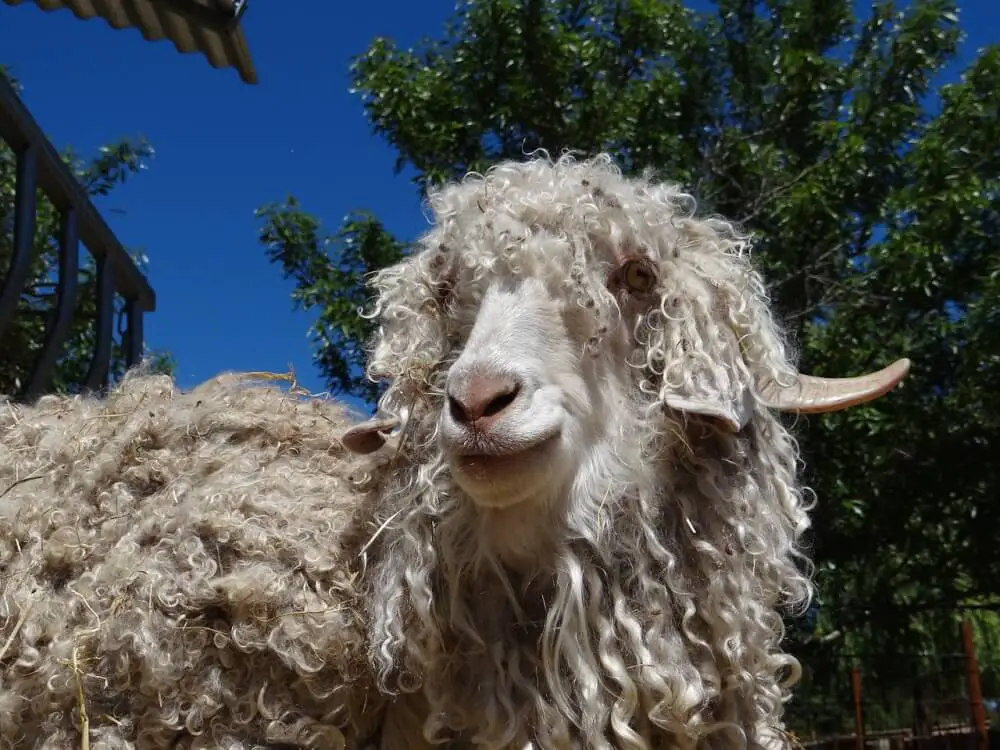Whether you’re looking for answers to your clothing, spinning, or knitting questions, you’re here because you want to know the differences between mohair vs wool.
Both mohair and wool keep you warm and are fire-resistant. Mohair is softer and smoother than wool, it has shine and drape similar to silk, and it is wrinkle and felt-resistant. However, mohair is much more expensive than wool and wool is springier.
To get all the juicy details of that super short breakdown, keep reading. We’ll talk about what mohair actually is and do a full comparison of mohair and wool.
Table of Contents
What is Mohair?

Mohair is a natural fiber that comes from the hair of the Angora goat (Ankara goat) which is a breed originating in Turkey.
Now, before we move on, we also need to mention the Angora rabbit. Angora rabbits produce Angora wool. Mohair and Angora are two different types of fiber produced by two very different animals.
So, to clarify, Angora goats make Mohair, and Angora rabbits make Angora wool. Now, let’s jump back into talking about Mohair.
The fiber is harvested by shearing the coat off the goat, the shearing process is usually done twice a year. The fiber is then washed, carded, and either sold to hand spinners or processed into mohair yarns and textiles.
According to World Atlas, South Africa is the leading producer of Mohair, accounting for about 50% of the world’s Mohair production. The United States, Turkey, and Australia are also major producers.
In recent years, ethical concerns have been raised regarding the treatment of animals at some South African Angora goat farms. When buying Mohair in any form, do your research to ensure you are buying responsibly.
Now that you have some background information regarding mohair, let’s talk about mohair characteristics.
Characteristics of Mohair

Mohair fibers usually have a 6-inch staple length (the length of the individual fiber) and a micron count of 24-45 microns (the width of the individual fiber).
The fiber will get thicker or thinner according to the age of the animal, younger goats will have thinner fibers while wool of older Angora goats will have thicker fibers.
A unique characteristic of mohair fibers has to do with the scales on the fibers. All hair, sheep, goat, and human, have tiny scales on them. This is why your hair feels smooth one way and grippy the other way.
On mohair fibers, the scales of the fiber are not fully developed which means it’s smoother than other fibers.
This feature gives it a few unique qualities that you won’t find in any other fiber. Although this gives it many interesting features, it can also cause some issues.
If you try to spin straight mohair fibers, they will be extremely slippery and hard to handle. Because of this, mohair is almost always blended with other fibers such as sheep wool and alpaca wool.
Let’s talk about the five main characteristics of mohair fibers and mohair fabric.
1. Warmth
Mohair is a very warm fiber and fabric while still staying lightweight. It is suitable for warm base layers as well as more complex items such as mohair suits.
Regardless of how it’s used, mohair blends will keep you warm.
But, it’s also breathable and has moisture-wicking capabilities which means it can also be used and worn during summer months without getting too hot.
2. Softness
Mohair is extremely soft. It has a low micron count which is the measurement of the diameter of the fiber. The lower the micron count the softer the fiber.
The mohair fiber does not have full scales like other natural fibres do. Because of this, mohair can be softer than some other fibers and is a great fiber for people with sensitive skin.
However, because it is so straight and smooth, it tends to poke out when it’s spun into yarn which can cause it to be itchy. For more info on mohair being itchy, check out this post: Is Mohair Itchy? How to Choose the Right Yarn
The slippery texture of the mohair also makes it so that the mohair yarn sheds while you’re working with it. Some people love mohair, some hate it, give it a try to form your own opinion.
3. Sheen and Drape
Many people compare mohair to silk because it has a sheen and drape comparable to silk. This is because the smooth fiber doesn’t have any scales.
It also has a long staple length which is the length of each fiber. The extra length means that the fiber can be spun into very thin yarn.
When thin yarn is woven into a fabric or garment, it gives it more drape. Drape is how easily the fabric forms to objects underneath it or how easily it ‘drapes’ over things.
This is why mohair fabric has an excellent drape.
4. Wrinkle Resistance
You read that right, mohair is wrinkle-resistant!
Once again, this property comes from the fact that mohair fibers have no scales on them. This prevents wrinkles from forming in the soft fabric because the fibers won’t get stuck to one another.
5. Felt Resistance
This one is pretty neat and a good one to end our list with. Mohair is resistant to felting.
Felting is what happens when you accidentally wash your wool sweater and it comes out looking four sizes too small.
Felting occurs because the scales on the wool fibers get all caught and jumbles together. Mohair has very small scales which makes it harder for them to get all stuck together.
Now that you know all about the characteristics of mohair, it’s time to compare mohair to wool.
Mohair Vs Wool

For this post, we will be comparing mohair with merino wool. There are a ton of different types of wool out there, but Merino sheep are by far the most common.
If you’re interested in other breeds of wool sheep, check out my post that has 23 Breeds of Wool Sheep Different Than Merino.
Now, let’s jump in and compare mohair vs wool.
Warmth
When it comes to warmth, mohair and wool are pretty similar. The only difference here is that mohair garments are a little lighter than wool garments.
Softness
In general, mohair will be softer than merino wool. However, it will depend on the age of the goat that the mohair is sheared from.
If it is an older goat, the hairs will be thicker in diameter which makes the fiber less soft.
But, mohair does not have hair scales on the fiber like wool does which makes it less irritating to people with sensitive skin.
Cost
In this category, merino wool comes out on top. Mohair is more expensive than wool. Whether it be mohair yarn, fiber, fabric, or garments, it will be more expensive than the wool alternative.
To demonstrate, let’s compare two balls of yarn from KnitPicks.
There is a lace-weight yarn that is 70% Merino and 30% silk. The skein is 50 grams in weight and yields 440 yards. This yarn sells for $8. Here’s a link to the yarn so you can check it out.
In comparison, there is a lace-weight yarn that is 72% mohair and 27% silk. It’s a 25-gram ball and yields 260 yards, half the size of the wool blend yarn. This yarn sells for about $10, here’s a link to the yarn.
So, it’s two dollars more to get half the amount of mohair yarn. Mohair is considered a luxury fiber which means you have to pay for the luxury.
Sheen and Drape
In terms of sheen, mohair will beat sheep’s wool every time. Mohair doesn’t have scales on the fibers which means it’s smooth and shiny. This lets it imitate some qualities of silk.
In terms of drape, mohair will usually have better drape than wool. But, it depends on how thin the wool yarn is and how the yarn was spun.
There are ways to spin wool that make it smoother and stronger or fluffier and warmer which are called worsted and woolen spinning respectively. For more information about these two methods of spinning, check out this post by Modern Daily Knitting.
Fire Resistance
Both mohair and wool have fire-resistant properties. When the fibers are exposed to an open flame, they will basically melt but they will not catch fire.
However, raw wool has lanolin in it which is a waxy substance that sheep produce that waterproofs and protects the wool while it’s on the sheep.
Lanolin is flammable so raw wool is not as fire resistant. But if your wool has been scoured (cleaned) or processed into a yarn or garment, the lanolin will no longer be an issue.
Related Questions
Is Mohair Itchy?
Mohair is not itchy because it doesn’t have scales on the fibers like wool and other natural fibers do. However, some people with sensitive skin or who are allergic to animal fibers may still find it itchy. Also, it is very rare for someone to be allergic to mohair so if you have had issues with animal fibers in the past, mohair might be worth a try.
Is Mohair Warmer Than Cashmere?
Both mohair and cashmere are great at keeping you warm. However, cashmere can be warmer than mohair. It’s difficult to compare the two because mohair is almost always blended with other fibers. Cashmere is the soft undercoat of Cashmere goats’ winter coat. For more information about cashmere, check out my other post that compares wool vs cashmere.

